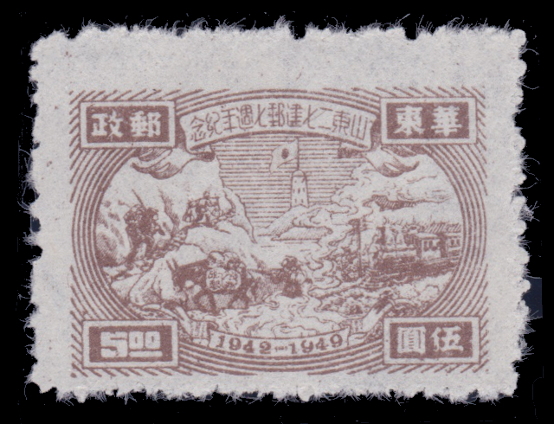
Host is localhost Log in | Basket Empty
Host is localhost Log in | Basket Empty
See related article about a block of the $5 used in a small village in Jiangsu.
View this set in the catalogue.
Or see the complete list of articles.
To visit other parts of the site, click on the title or other links above.

The story behind this set is an important part of the history of the war against Japan.
The Japanese occupied most of the cities and large towns in Shangtung from 1937 until 1945. However various, more remote, areas were still under local control of the Chinese. Many of these areas were controlled by groups run by or allied to the Communist Party.
On February 7th 1942, the Shandong Wartime Work Committee, a Communist Party organisation, established the Directorate General of the Shandong Wartime Posts in the Yimeng Mountains Area, centred on the town of Mamuchi, now in Yishan county district of Linyi city prefecture.
The Seventh Anniversary commemorative set was printed in Tientsin (modern Tianjin, which had fallen to the communists in January 1949) and widely distributed through East China, including Shandong.
This stamp was printed before all the others and differs from them, in that it depicts a Japanese flag on the tower.

The rationale for this was to show the ingenuity and bravery of the postal workers of the liberated area in evading Japanese interception of the Shantung Post.
However, before the rest of the stamps were printed, it was decided that it wasn't appropriate to show the Japanese flag on an East China stamp. So the flag was removed from the design of the other stamps.
Instead of reprinting and wasting all the $5 brown stamps already printed, it was decided to overprint the character (Post) to obliterate the flag.
The result was probably the stamp with the most varieties (easily seen) of any stamp ever issued.
The variety with missing overprint is shown above.
Reasons for the varieties include:
Many millions were printed of the $5, as for all the low values, but it is not so common used. The varieties are correspondingly more rare used and some may not exist used at all.
See related article about a block of the $5 used in a small village in Jiangsu.
View this set in the catalogue.
Or see the complete list of articles.